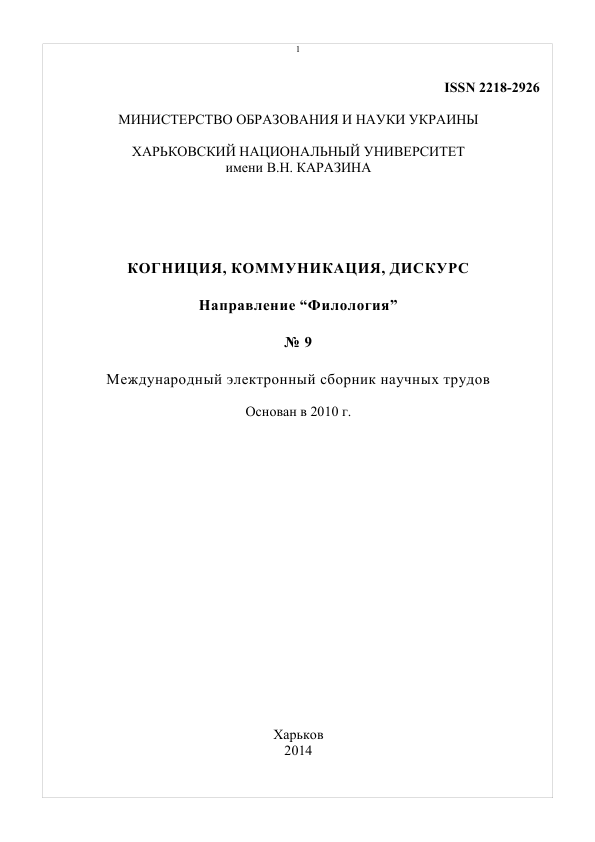“Вірменин” і “турок” як когнітивні концепти
Анотація
У статті розкривається необгрунтованість інтерпретацій, що відкидають факт Геноциду вірмен у Західній Вірменії на початку минулого століття. Широкий лінгвокогнітивний підхід до вивчення питання дозволяє автору із застосуванням теорії фрейма виявити значимість концептів “вірменин” і “турок”, наповнених відповідно позитивними і негативними стилістичними конотаціями і асоціа-тивними відтінками значення. Сформовані у свідомості людства когнітивні моделі слугують точкою відліку в сприйнятті, розумінні і правдивої інтерпретації однієї з найбільших трагедій в історії сучасного світу.
Завантаження
Посилання
Fillmore, Ch. (1982). Frame semantics. In: The Linguistic Society of Korea (ed.). Linguistics in the Morning Calm. Seoul: Hanshin Publ. Co., pp. 111-137
Gasparyan, S., Harutyunyan, G. and Gasparyan, L. (2012). Hayots tsegha-spanutyan artsartsumneri lezvachanachoghakan yurahatkutyunnery [Linguo-Cognitive Peculiarities of the Armenian Genocide Studies] // Lraber hasarakakan gitutyunneri, no 1(633). Yerevan: Gitutyun Press of RA NAS, pp. 184-189
Kubr’akova, E.S. (1994). Paradigmy nauchnogo znani’a v lingvistike i yeyo sovremennyy status [Paradigms of scientific knowledge in linguistics and its current status]. Moscow: RAN Publ.
Kubr’akova, E.S., Dem’ankov, V.Z., Pankrats, U.G. and Luzina, L.G. (1997). Kratkiy slovar’ kognitivnykh terminov [Concise dictionary of cognitive terms]. Мoscow: MSU Publ.
Lewy, G. (2004). The Armenian Massacre in Ottoman Turkey: A Disputed Genocide. Salt Lake City: University of Utah Press
Longman Dictionary of English Language and Culture. (1998). England: Pearson Education Limited
Melson, R. A. (1892). Theoretical Inquiry into the Armenian Massacres of 1894–1896. Comparative Studies in Society and History, XXIV, 3 July, pp. 481-509
Minsky, M.A. (1980). A Frame for Representing Knowledge. In: D. Metzing (ed.). Frame conceptions and text understanding. Berlin, NY: Walter de Gruyter, pp. 1-25
Paronyan, Sh. (2011). Lezvachanachoghutyun yev diskurs [Linguistics and Discourse]. Yerevan: YSU Press
Shaw, S. (1976). History of the Ottoman Empire and Modern Turkey, vol. 1. Cambridge: Cambridge University Press
Suny, R. (1993). Looking Toward Ararat: Armenia in Modern History. Bloomington and Indianapolis: Indiana University Press
Suny, R., Gûcek, F. and Naimark, N. (eds.). (2011). A Question of Genocide. Armenians and Turks at the End of the Ottomann Empire. Oxford: OUP
The Shorter Oxford English Dictionary on Historical Principles, vol. 2. (1978). Oxford: Clarindon Press
Webster, N. (1981). Webster's third new international dictionary of the English language unabridged: With seven language dictionary. Chicago: Encyclopaedia Britannica [u.a.].
Автори, які публікуються у цьому журналі, погоджуються з наступними умовами:
Автори залишають за собою право на авторство своєї роботи та передають журналу право першої публікації цієї роботи на умовах ліцензії Creative Commons Attribution License (CC BY), яка дозволяє іншим особам вільно розповсюджувати опубліковану роботу з обов'язковим посиланням на авторів оригінальної роботи та першу публікацію роботи у цьому журналі.
Автори мають право укладати самостійні додаткові угоди щодо неексклюзивного розповсюдження роботи у тому вигляді, в якому вона була опублікована цим журналом (наприклад, розміщувати роботу в електронному сховищі установи або публікувати у складі монографії), за умови збереження посилання на першу публікацію роботи у цьому журналі.
Політика журналу дозволяє і заохочує розміщення авторами в мережі Інтернет (наприклад, у сховищах установ або на особистих веб-сайтах) рукопису роботи, як до подання цього рукопису до редакції, так і під час його редакційного опрацювання, оскільки це сприяє виникненню продуктивної наукової дискусії та позитивно позначається на оперативності та динаміці цитування опублікованої роботи (див. The Effect of Open Access).




